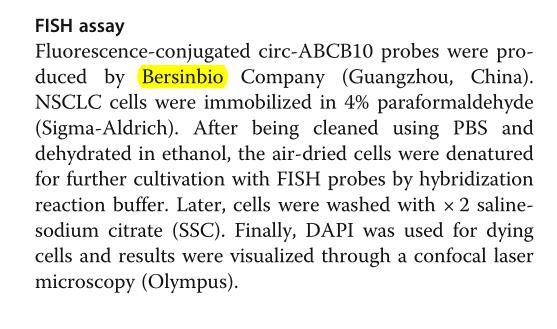research target:Circ-ABCB10, Cisplatin, miR-556-3p, AK4, Lung cancer
Periodicals:BMC Pulm Med
IF:3.314
Cooperative Unit:Zhuzhou Hospital Affiliated to Xiangya School of Medicine, CSU
Time of publication:January, 2020
 Summary
Summary
Background: Due to the acquired drug resistance, the potency of cisplatin-based chemotherapy is limited in lung cancer, which is a big obstacle in clinical treatment of lung cancer. Abundant evidence has revealed that circular RNAs (circRNAs) exerted facilitating or suppressive function on the tumorigenesis of multiple cancers. The oncogenic role of circ-ABCB10 in breast cancer and clear cell renal cell carcinoma has been validated in recent researches. However, the regulatory mechanism of circ-ABCB10 and its relation to cellular sensitivity to cisplatin in lung cancer is poorly understood.
Methods: The expression and characteristic of circ-ABCB10 were analyzed by RT-qPCR and nucleic acid electrophoresis.CCK-8, colony formation, TUNEL and transwell assays were applied to probe the role of FOXD3-AS1 in lung cancer. The interactions of miR-556-3p with circ-ABCB10 and AK4 were testified by luciferase reporter and RIP assays.
Results: Circ-ABCB10 was markedly upregulated and featured with loop structure in lung cancer. Circ-ABCB10 depletion suppresses lung cancer progression and sensitizes lung cancer cells to cisplatin. Molecular mechanism assays manifested that circ-ABCB10 bound with miR-556-3p and negatively modulated miR-556-3p expression. Additionally, AK4 was testified to be the downstream target of miR-556-3p. More importantly, rescue assays clarified that upregulation of AK4 could reverse the cisplatin-sensitizing and tumor-suppressing effect of circ-ABCB10 knockdown on lung cancer cells.
Conclusions: Circ-ABCB10 knockdown enhances sensitivity of lung cancer cells to cisplatin by targeting miR-556-3p/AK4 axis.
Partial results of cooperation

 BersinbioTM cooperative technology:FISH probe
BersinbioTM cooperative technology:FISH probe
Original link:10.1186/s12890-019-1035-z


